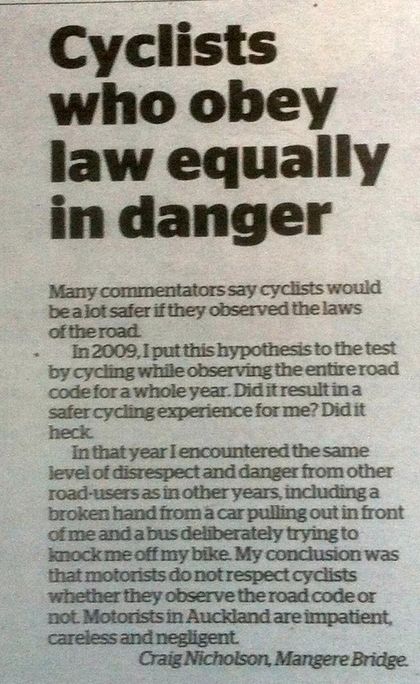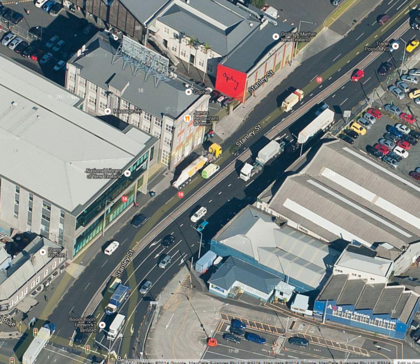We'll never know exactly what was in John Tangiia's mind when he slipped left through the red light at the bottom of Parnell Rise and into the path of a truck. But I know what I would do if I had to make that turn. As a reasonably experienced urban cyclist, I would have broken the law in another way.
Here's that intersection on Google Maps (you may need to switch off the 45º view at the top right to get a better look at it). Port traffic, including heavy trucks, passes acrross it from The Strand into Stanley Street, which provides direct access to all three of the motorways that touch central Auckland: the Southern, the Northern and the Northwestern.
In theory, it's open to cycle traffic. In reality, there is no safe room for cyclists, who should use the footpath all the way up to The Domain, road rules be damned. And that, really, is the flaw in any argument that cyclists shoud behave just like every other road user in Auckland. More of us would die or be injured if we did.
That fact should influence our reading of today's Herald story on cyclists and red lights.
Cyclists accounted for 60 per cent of red-light runners surveyed at four Auckland intersections, the city's transport authority has revealed.
Car drivers were responsible for 37 per cent of 360 red-light breaches observed by Auckland Transport, and buses, trucks and one motorcycle made up the balance.
The survey was taken nine months ago, and used by Auckland Transport to formulate safety messages aimed at encouraging all road users to obey red lights, but was not publicised at the time.
It was taken during 12 peak travel hours over two days in late March at two intersections on Tamaki Drive, one at the junction of Quay St and Lower Albert St, and the other at the Newton-Great North-Ponsonby-Karangahape crossroads.
The last of those is the only one I ride through regularly. It's a reasonably complex intersection, with both left and right arrow turns. Would I simply bowl through a red light there? Hell, no. That would be crazy. Coming from the Chev, might I slip left around the corner into Ponsonby Road on a red light? Probably not. If I was in that much of a hurry, I'd use the footpath for a short stretch. But if I'm heading straight on into K Road, I'll probably edge up onto the pedestrian crossing to get a start on the traffic when the light changes and to avoid blocking the left-turn lane for motorists. In theory, I suppose I've breached the red light. It's safer that way.
Coming home, there is, in theory, a left turn from Karangahape into Newton Road, down the hill to join the S16 cycleway. It's quite legal -- that's the way the signals and lane markings all point. But the entry to the cycleway is right next to the on-ramp for the motorway itself. It would be unsafe to be messing about there.
Welcome to cycling in Auckland, where the city's incomplete cycling network creates almost as many hazards as it avoids. When a cycleway network is incomplete, its on and off points become dangerous. Back on Stanley Street, it's possible to cross the road and use the short stretch of cycleway on the western side, but actually getting on and off that at the Alten Street corner is a total mess.
In theory, that short stretch is part of an extension to the S16 cycleway which is supposed to come all the way down Grafton Gully to Beach Road and beyond, but while NZTA has built part of its share of the path, Auckland Transport seems completely stalled on what's meant to be its part of the project.
A lack of coordination between the two agencies, with Auckland Transport dragging its feet, is pretty much the story of dedicated cycleways in the city. While cyclists coming in from Te Atatu on the SH16 cycleway are presently getting a nice new upgrade over the causeway, along with the motor traffic, anyone who wants to use to Te Atatu Road to actually get to the cycleway is shit out of luck. I would not cycle on Te Atatu road south of the motorway at rush hour. It's terrifying. (Again, the safest option is to ride on the footpath.)
I'm sorry if this all seems opaque and confusing, but this kind of detail is the reality of riding in Auckland. We cyclists think about these things all the time, and more so in the past week than ever. Transport Blog has a comprehensive look at where the city's cycle plans are at (progress is slow and compared to roads budgets are tiny). Ben Ross takes a useful look at what could be done to make the roads safer for cyclists. And Cycle Action Auckland has a number of posts, including one titled Why the traffic environment counts even when someone runs a red light.
I think that last one nails it. People will make mistakes and poor choices. The idea is to get to a point where the penalty for making a mistake isn't death, and where the "correct" route isn't too risky to countenance. This helps everyone, cyclists and motorists. Remember, there were two victims at Stanley Street -- John Tangiia and the poor truck driver who will never be able to forget the man who went under his wheels.
There are many benefits to cycle-commuting, from better public heath to fewer cars on the road. When motorists are used to sharing roads with cyclists, overall traffic safety improves. But it's not hard to understand why more people don't do it now.
Gemma Gracewood and Greg Wood collaborated on a Metro feature last year looking at New York's successful cycle transformation and potential lessons for Auckland. There are many differences between the two cities and I think Auckland is going to present challenges. For the moment, our best cycleways are built as add-ons to motorways -- outside those, the official options are confusing. We need to do better.


